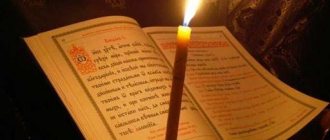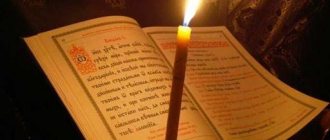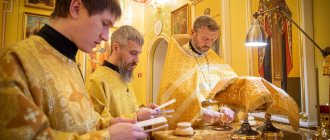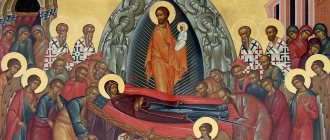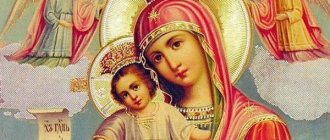Remembrance of the Dead
Grief and sadness come to the house of the deceased.
Death in Orthodoxy is a great sacrament, the end of earthly life. The soul, leaving the body, sets off on a new journey. She goes through 3 states - from the mother’s womb to earthly life and afterlife. Repentance before death and the funeral service for the deceased will help the soul to be cleansed of sins. After death, the deceased also need charity for their souls. Praying for the deceased will help not only his soul. They will bring calm and peace to the hearts of loved ones and relatives. There is a special prayer - an akathist for the one who died (or the same one). Reading it will help the soul of the deceased find peace.
https://www.youtube.com/watch?v=2BeqWKP0wFo
Prayers for one who died are prayers for only one person. The clergy recommend reading the Psalter - it is the word of God. While an akathist is folk art. Relatives and loved ones in home commemorations rely on their feelings during prayer. An akathist for the one who died is heartfelt words that will help console the living and reconcile them with the death of a loved one.
Deceased relatives and friends need help from the living. The clergy assure that with sincere and constant appeals to the Heavenly Father, one can beg a soul even from hell.
No one knows where the soul will be found after death until the Last Judgment. Therefore, the spiritual help of loved ones and relatives will always be relevant. At the liturgy in the church, all baptized deceased are remembered (to do this, you must submit a note with the name of the deceased). You can order a sorokoust - then he will be commemorated at the service for all 40 days. It is optimal to order a memorial service in the church on days 3, 9, 40.
Good deeds are the same intercession for the deceased. Almsgiving, helping the sick or the poor is a charity that will contribute to the atonement of sins and the acquisition of grace. Righteous John of Kronstadt warned that if there is no love for one's neighbor, then alms will be in vain. Only with kindness and a sincere heart, with regret for poverty or illness, is it worth doing deeds of mercy. Alms are a benefit primarily for the one who gives them.
The amount of donations or the number of funeral services ordered is not important. The only thing that matters is the feeling with which a person asks for the deceased.
An akathist for the one who died is also an intercession. When should I read it? Immediately after death, 40 days in a row and 40 days before the anniversary. Prayers make the afterlife easier. The good memory of the deceased must be accompanied by deeds. Clean up the grave, plant flowers, put up a cross. Such simple actions are not always performed by relatives.
During the time of persecution of the Russian Orthodox Church, akathists became widespread
The akathist became widespread in Orthodoxy in the 19th-20th centuries. Alexei Popov, in his work “Orthodox Akathists...” claims that in the Russian Empire by 1901, censors working in the spiritual department approved 158 akathists for publication.
The first anthem in Russia was composed around 916. It is dedicated to Sergius of Radonezh.
Trial of a priest. Photography from the 20s. In the USSR, during the period of persecution of the Russian Orthodox Church, there were not enough priests
They became most in demand after the revolution occurred in Russia in 1917. This is due to the fact that, unlike other liturgical texts, the akathist can be read without a priest.
In the USSR, they were used for simplified home services in the absence of people who knew the liturgical regulations. In addition, government officials “turned a blind eye” to the singing of psalms, but the full liturgy was severely persecuted.
The anthem traditionally has a small volume, which facilitates the process of copying it. Moreover, a large number of akathists in modern times were written not in Church Slavonic, but in its Russified version. This made them much easier to understand by ear.
See also the article Is it possible to read an akathist while sitting?
On what occasions is the Akathist read?
Church ministers recommend resorting to the help of Akathist in situations:
- When moving to a new home.
- In case of insufficient funds.
- To get rid of sins.
- To protect children, relatives and friends.
Reading prayers is due to different motives.
During chanting it is possible to address saints or the Virgin Mary. It depends on the request with which you came to the higher heavenly powers.
The Mother of God in Orthodoxy is the most important saint. If you believe in her divine powers and persistently ask every day for your prayer to be fulfilled, then she will definitely hear it.
People most often ask the Virgin Mary for recovery. This is a strong saint, under her protection any miracle is possible. Seriously or terminally ill people who believe in the Mother of God have been cured more than once.
People suffering from drug and alcohol addiction come to Our Lady. The Virgin Mary helps them only on the condition that these people want it. Cathedral in the name of Alexander NevskyWhat is special about the temple in Novosibirsk? Who is the author of the architectural ensemble and why do people from different parts of the world come to the church?
Heavenly patrons often relieve a person from depression. In this situation, they are a consolation for the spiritually ill, support in difficult times.
The saints are asked for improvements in material and physical terms.
Why do they read it?
People read the Akathist completely
Orthodox Christians believe in the spiritual power of prayer because it will bring them positive results. for reading the Akathist, grief, loss or mental anguish of a person is considered. Then he seeks consolation in prayer, hoping for help from the saints or the Mother of God.
People who have recently come to faith independently analyze what is written in Akathist. This is useful, because it gives a person. Thus, people find harmony with themselves, are imbued with the joy or grief of this or that prayer. (see History of the Icon of the Kazan Mother of God)
Christians believe that after reading the songs, their doubts will be cleared, and this will help them make the right decision.
There are Orthodox Christians who read prayers several times every day. This action of theirs is associated with various reasons: they ask God for healing from an illness, some earthly blessings, or they listen for protection
Structure of the akathist about the one who died
The structure of the hymn consists of 25 songs - 13 kontakia and 12 ikos. They alternate. The unpaired, 13th kontakion is worn three times. After it, the first ikos is read and again the first kontakion.
The word “akathist” translated from Greek means “unsaddled song.” That is, you cannot sit during the anthem.
The first kontakion and all ikos end with the call “Rejoice.” The remaining 12 kontakia end with the word “hallelujah.” The anthem is most often read at home. Therefore, it is quite possible to pronounce it without the special blessing of the priest.
We invite you to familiarize yourself with: Solstice Kolovrat symbol
Prayers at home are read at the request of the laity. It is not necessary to stand in front of the iconostasis. The Akathist allows reading without images. In this case, the inner attitude is more important. A lazy, relaxed state of mind will not benefit the deceased. A pious, humble attitude to prayer will be evidence of love for the one commemorated. Diligence in reading is comforting both for the soul of the deceased and for the soul of the one who remembers.
How to read the akathist for the one who died at home? The Charter does not provide clear definitions in this case. It all depends on personal attitude and diligence. The akathist is read in full, from beginning to end, followed by a special prayer.
Let us repeat once again: if there is no iconostasis in the house, it doesn’t matter. It is permissible to read prayers in front of a window or with your eyes closed. The pose of the person asking depends on the state of health. If it is difficult to stand on your feet or on your knees for a long time, you can pray while sitting.
The reading of the akathist for the one who died at home can be timed to coincide with daily appeals to the Lord. For example, read the morning prayer, followed by the akathist itself, then the prayer after the akathist. Evening church texts are read according to the same principle.
Relatives of the deceased, worried, ask the clergy: “Is it possible to write down an akathist for the one who died on a piece of paper? How to read it - out loud or silently? The anthem can be read from a book or by heart. There are even special audio and video recordings that can be played during home prayer. As for the question of how to pray - out loud or in a whisper, the answer to it is determined by each person independently. As you prefer.
You are allowed to pray for the deceased in your own words. It is not necessary to look at the brochure or learn the akathist by heart. If the words come from the heart, they will be heard.
Canons and akathists
The canon is a church hymn for glorifying the Savior, the Mother of God, the Most Holy Trinity; glorification can also refer to some saint or church holiday. The first canons were created back in the 7th century. The canons form the most important part of the church service, but Orthodox Christians can also read them privately, that is, at home. Certain canons must be read when preparing for communion.
An akathist is a chant of praise that is part of the liturgy, but can be read separately at home.
It sings in poetic form the most important moments from the life of the Savior, Our Lady or the saint to whom it is dedicated. From Greek, akathist is translated as “singing without sitting down,” however, an exception is often made for the sick and those who are very old and praying. Reading while standing does not allow you to relax and reduce the intensity of prayer, so at home you need to do it while standing.
An akathist addressed to saints with a prayer request is often read by believers, but first you must receive a church blessing for this, even if you read it at home and not in church. It is best to read it according to the Orthodox prayer book. As a rule, the akathist or canon is read at the end of the morning or evening prayer, at the very end before the prayer “It is worthy to eat,” but a separate reading of the akathist is also possible.
It should be remembered that first it is necessary to say special prayers before reading the akathist, and if we are talking about the canon, then the corresponding prayers before reading the canon.
On what days is the akathist read?
Monday
The first day of the work week should begin with “public prayer.” It will set a good rhythm for starting work. The church hymn is dedicated to the Guardian Angel, he will look after you for all seven days. This way there will be fewer bad situations in your life.
He often directs the energy of the person under his care in the right direction so that he does not waste it on unnecessary things. At the discretion of the worshiper, you can read an akathist to Archangel Michael. The powers of this saint are enormous, he will exert an influence to save you from misfortunes that could not be predicted in advance.
Tuesday
On the second day of the week, you need to read a prayer to John the Baptist - the holy saint who grants repentance to a person.
In Ancient Rus', John the Baptist was revered. On his holiday, people dressed in the most beautiful outfits and went to celebrate this day on a grand scale.
His main admirers were peasants working the land. It was believed that the saint, with the proper attitude, rewards a person with an excellent harvest and fertile land. If there was a possibility that some natural disaster could destroy crops, they prayed to John the Baptist.
Nowadays farmers and gardeners use this rule.
It's the middle of the work week. It means that the difficult first days have already passed, but it is still too early to relax.
Prayers read on Wednesday - Akathist to the Mother of God, as well as to the Sweetest Jesus. On this day, expectant mothers ask the Virgin Mary for a good pregnancy, protection or healing of their children.
Thursday
On this day, St. Nicholas the Wonderworker and the holy apostles are glorified.
The date is well suited for asking Nicholas the Wonderworker for health and recovery from any illness.
The apostles Peter and Paul are asked for advice in accomplishing difficult matters. If you are taking on something new, opening a business, going to work, or finding a craft in which you have not tried yourself before, then you need to pray to these apostles. Then success awaits you in all your endeavors.
Peter, according to biblical legends, is a fisherman. He is the patron of this business. Therefore, for a good catch, you should ask him for assistance. (see Spassky Cathedral of the Andronikov Monastery)
Friday
The fifth day of the week was of great importance in the events surrounding the crucifixion of Jesus Christ. The Bible says that this cruel act took place on Friday.
Today, in all church institutions of the country, chants are held on this day, glorifying the Life-giving Cross of the Lord.
Ordinary people can go to church or read the Akathist themselves, dedicated to the Honest and Life-Giving Cross of the Lord God. You are allowed to ask the shrine for protection from any troubles not only with the person praying, but also with his relatives. They read a prayer book to protect themselves from illnesses and evil forces manifested in envy, the evil eye or corruption.
Saturday
It is customary to devote the day before the weekend to the service of the Mother of God and some saints. People distracted from everyday work do other things. We advise you to take a little time before your classes to read the Akathist to the Queen of Heaven. If one of the saints is your guardian angel, then it is recommended to read a prayer to glorify him.
We invite you to read: How to read psalms for every need
Resurrection
In the religious world, Sunday is the first day of the week. Any Orthodox Christian knows that on the seventh day of the week the Son of God, Jesus Christ, was resurrected.
Sunday should be dedicated to going to church to honor this great event. This is the last day when God created the Earth, according to the Bible it was said that today you cannot work, you need to relax, engage in your favorite hobby or spend time with your family.
Akathist of the Resurrection of Christ is the final stage of reading prayers in the week. A person thanks God for the successful accomplishment of affairs and prepares for new achievements.
In order for God or the saints to hear you, you must adhere to the rules of reading the Akathist. This will help you establish a strong connection with the Heavenly forces and then they will quickly heed your requests.
We recommend that before you start praying on your own, go to the temple and listen carefully to how the Akathist is sung there.
If at the moment a person does not have the opportunity to visit a church institution, resort to live broadcasts of worship services; they are held on specialized religious channels.
The akathist for the one who died reads:
- within 40 days after death;
- within 40 days before the anniversary.
A one-dead person is one deceased person for whom prayer words are pronounced. The entire text of the anthem is presented in the singular.
Is it possible to read an akathist for one who died on Holy Week? The Holy Fathers warn that on some holidays the Charter prohibits the reading of the hymn. So, these texts are not read on Holy and Bright Week.
Another common question: “Is it necessary to read an akathist for the one who died on Easter?” Since the holiday falls on Bright Week (it lasts from the Resurrection of the Lord until Saturday inclusive), the mentioned prayer is not offered. But you can recite the words of the Easter Canon or read the Acts of the Holy Apostles all week - this is the same prayerful help to the deceased as the hymn.
Reading canons and akathists during the week
In the tradition of the Orthodox Church, since ancient times, certain events or saints are remembered during divine services on different days of the week. Over time, the liturgical tradition of the Church spread to home (cell) prayers. Thus, Monday’s service contains prayers to the Heavenly Powers, Tuesday’s service contains prayers to John the Baptist. On Wednesday, Friday and Sunday, the Holy Church remembers the Gospel events of the betrayal of the Savior, His Death on the Cross and Resurrection, respectively, and the liturgical tests are dedicated to the Lord and the Most Holy Theotokos. Saturday is traditionally the day of remembrance of the dead and special prayer to all the saints from the ages who have pleased God. Particular attention should be paid to Thursday - the day when the memory of the holy apostles and St. Nicholas the Wonderworker is celebrated.
On what day should you read which akathist and canon?
Following the rules of piety and imitating the liturgical order, the laity read the canons and akathists:
On Monday: Canon to the Incorporeal Heavenly Powers Canon to the Guardian Angel Akathist to the Holy Archangel Michael Akathist to the Holy Guardian Angel
Tuesday: Canon of repentance to our Lord Jesus Christ Canon to St. John the Baptist Akathist to the holy glorious prophet, Forerunner and Baptist of the Lord John
Wednesday: Canon touching the Lord Jesus Christ Canon of prayer to the Most Holy Theotokos Akathist to the Sweetest Jesus Akathist to the Most Holy Theotokos
Thursday: Canon to the Holy Apostles Canon to St. Nicholas Akathist to the Holy Chief Apostles Peter and Paul Akathist to St. Nicholas the Wonderworker
Friday: Canon to the Honorable and Life-giving Cross of the Lord Canon to the Divine Passion of Christ Akathist to the Honorable and Life-giving Cross of the Lord Akathist to the Divine Passion of Christ
Saturday: Canon for the repose of the departed Canon to all saints from the ages who have pleased God Akathist to all saints Akathist for the repose of the departed
Sunday: Canon Sunday Tone 6 Akathist to the Resurrection of Christ
In general, the order of reading in different traditions may differ slightly. For example, on Wednesday, in some publications, instead of the canon of prayer for the Mother of God, they publish the canon of the Most Holy Theotokos “Hodegetria”.
How to read canons and akathists for every day?
There are two traditions of reading canons and akathists for each day of the week. The canon is read separately and the akathist separately, or the canon is read, after the 6th song of which the akathist is read, without prayer, then the canon ends and prayers are read.
The beginning and end of the reading of canons and akathists is usual.
The ordeal of the soul after death
According to church tradition, the soul begins ordeal after death. They last 40 days, so prayers for the same deceased at this time are considered the most effective.
After death, in the first 3 days the soul is at the coffin, next to its relatives. From days 3 to 9 she flies around the heavenly abodes. From days 9 to 40, she contemplates hell and the torment in it. All material goods - an expensive coffin, a monument - become unnecessary for the soul. It connects with the world of spirits, where cleansing from earthly sinfulness is more important.
Repentance before death helps to start a new path. The prayerful help of loved ones and their good deeds in memory of the deceased is necessary spiritual, sacrificial work. The Holy Fathers say that the seat of passions is the soul, not the body. No one knows what suffering is in store for this immortal substance after earthly life, what passions will torment it. That is why it is worth asking for remission of sins and forgiveness of the deceased.
In earthly life we encounter small temptations and do not always strive to overcome them. Ordeals are a test of the strength of the soul, a test of good and evil. Repentance before death can change a person’s inner mood. Prayers after his death will help the soul pass the tests.
The most complete collection of akathists is located on the website akathistnik.ru
In the Russian Orthodox tradition, there was the writing of akathists to any Russian saints who began to be glorified by the Orthodox Church. Since before the revolution the texts of akathists were necessarily checked by church censorship, there were not so many of them.
In the twentieth century, there was no such filter, so hymns were actively compiled and distributed by typewritten method.
Home page of the Akafistnik.ru website The most complete collection of Akathists is collected here
After the collapse of the USSR, there was a new surge in akathistography. The most famous authors of such works are Evgeny Khrapovitsky and Alexander Trofimov. Akathists are written not only in Russian or Church Slavonic, but also in other languages.
Currently, according to priest Maxim Plyakin, there are 1,800 such works. The most complete akathist book is located on the Akathist website. RU
Rules for reading the akathist to saints
What is an akathist? This is a song of praise, thanksgiving dedicated to God, His Mother, saints, angels, archangels.
Akathist is a song of praise, thanksgiving dedicated to God, His Mother, saints, angels, archangels
The song of praise includes 25 songs, divided into two groups:
- Kontakia - 13 works, embodying in their lines a brief summary of the holiday or an ode of praise to the saint; its reading always ends with the praise of “Hallelujah”;
- Ikosy - 12 works that explain the essence of the festive event, always ending with the exclamation “Rejoice”.
Not every Christian understands how to read the akathist correctly.
Attention! Relaxation is made only for pregnant women and infirm people - they are allowed to read it while sitting, or, in extreme cases, lying down.
- Translated from ancient Greek it means “unsaddled singing.” Therefore, the solemn anthem is always performed in a standing position.
- With the blessing of the priest, it can be read both within the walls of the temple and at home.
- Before pronouncing it, pre-initial prayers are read; they are said before the main prayers begin.
- After reading them, an akathist and a prayer are read.
Important!
Solemn hymns are allowed to be offered on any day except Lenten days. Briefly describing the contents of the prayer book, we can say that it consists of large and small prayers. There are 25 poetic religious songs in total, from which it is necessary to isolate 12 kontakia headed by a long prayer, the rest of the prayers belong to ikos.
We invite you to familiarize yourself with: Tower Tarot meaning, 16 Arcana in layouts, combination of cards
Kontakion is a brief retelling of the act of a saint or historical event, presented in a short poetic passage.
Ikos is a voluminous song dedicated to the praise of a specific saint. Red Hill in 2022 This is a very old holiday for the Russian people, it carries deep religious and historical significance. But now not all residents of Russia remember about him.
Before starting to read the Akathist - the main part, you need to turn to a small prayer - “Our Father”, which is always read in the morning. It is possible to combine morning and evening chants, then the beginning will be the prayer “Our Father”, in the middle the Akathist, and the process should be concluded with the prayer “She is worthy.”
But if you forget to say the opening prayer, this is not a mistake and does not lead to sin. If you are a believer and devote yourself to prayer with all your soul and sincerity, then the Mother of God or the Lord will definitely hear it.
Remember that strict canons are needed for clergy.
Let us conclude that the Akathist for the Orthodox world is a hymn, a glorification of all heavenly powers. In it you can find any saint you want to contact.
The main rule for reading the Akathist is a person’s own faith in God. Only with a competent attitude towards religious ritual is it possible to achieve the right result.
Akathists in Christianity
Church akathists are not considered obligatory services, except for the akathist “Chosen Voivode” dedicated to the Mother of God (on Saturday during the fifth week of Easter Lent). In Greek, the word “akathist” means “unsaddled singing.” This is a doxology and hymn to the Lord, Our Lady, saints and archangels. Akathist singing is always performed standing; relaxation is allowed only for seriously ill people. Akathists are chanted on any day except Lent. They are performed in cathedrals and at home, but only with the blessing of the priest.
Spiritual almsgiving
Relatives and friends of the deceased do not always have the opportunity to donate to the temple, give alms, or order a memorial service. There is such a thing as spiritual almsgiving. It does not require financial investments. At the same time, it can bring tangible benefits to the soul of both the living and the deceased. What is its essence?
This is spiritual help to another person. It can consist of kind words of support and encouragement in difficult times. Or the free distribution of books with spiritual content.
If someone you know is in grief or sadness, even the smallest words of comfort can be beneficial. Thus, spiritual support for the grieving person is also a sacrifice for the sake of the soul of the deceased.
Deeds of mercy and prayers with love are a tremendous force that will help atone for the sins of the deceased and return God's grace to him.
Is it possible to read an akathist at a grave?
Visiting the cemetery is the responsibility of friends and relatives of the deceased. But you shouldn’t go to the grave against your will. A sincere desire to help the deceased should be the reason for visiting the cemetery or praying for the deceased.
You cannot arrange a wake at a grave - for Christians, only prayers and kind words about the deceased are optimal. You can light candles and tidy up. Relatives sometimes ask the Holy Fathers: “How to pronounce an akathist for one who died in a cemetery? Is it possible to read it on the grave?”
If there are a lot of people in the cemetery, then reading the akathist is unlikely to be beneficial. You should not be distracted from prayer by worldly concerns. Therefore, it is better to come to the cemetery on a day when no one will be nearby. Prayer words should sound in silence and calm. Then intercession for the deceased will benefit him. You can light candles and bring a small icon.
The clergy especially insist that there should be no wreaths or artificial flowers on the graves of Christians. Fresh flowers are a symbol of life and Resurrection. Therefore, it is better to bring one fresh flower to the grave than to cover it with artificial wreaths.
The grave in Orthodoxy is considered the place of future ascension. It must be kept clean and tidy. The immortal soul feels the need for constant prayer, since it cannot ask for itself. Reading the akathist and prayers at the grave of the deceased is the duty of a Christian.
Compilation of akathists first began in Byzantium
The meaning of the word akathist is deciphered in the literature of Greece of the Middle Ages. Its first mentions were recorded in early Byzantine times. It was from there that the tradition of composing such songs of praise later came to Eastern Europe.
Information about them is often found both in fiction and in historical sources.
“Praise of the Mother of God with Akathist” icon, XIV century. The first akathist that has come down to us is the Akathist to the Most Holy Theotokos
During the reign of the Byzantine Emperor Heraclius I, an akathist to the Blessed Virgin Mary was written
The first hymn that has come down to us, composed according to the rules of the akathist, is considered to be the akathist to the Most Holy Theotokos. It was created around 626, during the reign of Emperor Heraclius.
At the same time, hymnographers claim that its text included lines written earlier than this date.
The authors of this work are called several hymnographers, whose names have not reached us. In particular, co-authorship is attributed to Roman Sladkopevets, which cannot be confirmed or denied. The history of writing this akathist is wonderful.
The fact is that once the Scythians and Avars besieged Constantinople. There was nowhere to wait for help. Then Patriarch Sergius of Constantinople decided to walk with the image of the Most Holy Theotokos along the city walls, walking around the city with the icon.
After this, the attackers lifted the siege. The Mother of God appeared to Sergius and inspired him with the idea of composing a song of praise in her honor. It was from this moment that the Byzantine emperor began to consider the Mother of God the patroness of the city.
Blachernae Church. Modern look. The Akathist to the Most Holy Theotokos was originally read here
Initially, the reading of the akathist was carried out in the Blachernae Church. The miraculous image of the Mother of God, Her robe and belt were kept here.
Then they began to read it throughout Eastern Europe on the day of the holiday of the deliverance of Constantinople from its enemies. The remaining akathists are written in imitation of the akathist to the Most Holy Theotokos.
Opinions of clergy about the akathist
The Holy Fathers do not always welcome the reading of akathists about the one who died. Some of them admit that the commemoration of the dead can be combined with this hymn. The essence of the akathist is a joyful, laudatory song. In Orthodoxy there is no death as such. And there is the repose of the soul into eternal life. The Savior's victory over death, the immortality of the soul and its union with the Lord is joy for a Christian. Therefore, the akathist for the one who died should be read with this attitude.
There is another opinion on this matter. Thus, some clergy claim that the akathist for the one-dead (one-dead) is of dubious origin. This statement is based on some facts.
- The inner meaning of the anthem is contradictory. This is the praise of the Lord, the Mother of God or the saints, and not intercession for the dead.
- The Akathist does not have the permission of His Holiness the Patriarch or the liturgical commission.
- Replacing the reading of the Psalter with an akathist will not bring peace of mind either to the living or to the deceased.
Therefore, the solution to the question of the laity about how to correctly read the akathist for the one who died should begin by agreeing with his priest. Only with his approval is it permissible to read this hymn.
How to correctly sing Praise to God: reading Akathists to the Saints
How to correctly read the Akathists praising the Lord Jesus Christ, the Mother of God, the Saints and Great Martyrs. How to sing aloud correctly songs of praise to God and the Saints, and what rules need to be followed when reading the Akathist out loud.
Dear reader, you must understand: As a prayer instrument, the Akathist for spiritual development is a very powerful tool: “A song of praise to God and the Saints.” And it has a reverse reaction on the physical plane, when your sinful Soul lived only by the crafts of the earthly plane.
Praise be to God is a song of Thanksgiving, to all the Saints of the Army of Christ.
God and the Saints hear songs of praise and send attention to you. As a result, the sins of your Soul are first cleansed through events in life, health, family problems, all the dirt of your Soul is lifted from the bottom during the singing of praise to the Saints, the Mother of God, and the Lord Jesus.
Reading prayers and psalms is weaker than reading an akathist. For any Orthodox believer, this is the first step on the spiritual path to God, start reading psalms and prayers.
How to correctly read Akathist: Songs of Praise to the Lord, Saints and Mother of God
photo reading of the Bible and Psalms, instead of an akathist. This is the first step towards Reading Praise to God.
- Akathist read the text by voice and standing
- Church burning candle
- Placing a cross during reading and bowing; at the words Rejoice, a desire arises to cross and bow.
Three simple conditions when reading the Akathist, but it is advisable to have a hardcover book edition of the Akathist in order to sing songs of praise to God, the Saints and the Mother of God and the Great Martyrs. While reading, you need to carefully read and listen to every word in PRAISE TO THE SAINTS and not miss the end of the word in Old Church Slavonic. While reading the words from the akathist, your Soul is cleansed and filled with spiritual energy.
Akathist read a song of praise by day and on the day of remembrance of the Saint
- Akathist is read to St. Nicholas the Wonderworker on Thursdays and memorial days: December 6/19 and May 9/22
- The Akathist is read to St. Archangel Michael, on Mondays and Memorial Days November 8/21
Which akathist to read and on what day, usually in the book there are instructions at what time to read, on what day and when the Saint’s memorial day.
Attention: reading the akathist from 12 am to 3 am, you cannot read it. This must be taken into account during regular reading of the akathist.
Start your morning with a small morning prayer rule; how to start a prayer rule, read the article: Small morning prayer rule.
The path to God - found the answer, put your finger up
Subscribe to thematic channel: Path to God
